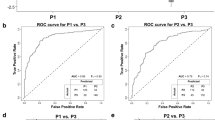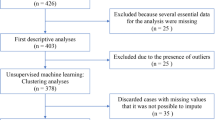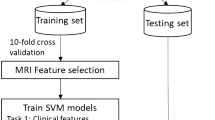Abstract
The current study applied data-driven methods to identify and explain novel cognitive phenotypes of HIV. Methods: 388 people with HIV (PWH) with an average age of 46 (15.8) and median plasma CD4+ T-cell count of 555 copies/mL (79% virally suppressed) underwent cognitive testing and 3T neuroimaging. Demographics, HIV disease variables, and health comorbidities were recorded within three months of cognitive testing/neuroimaging. Hierarchical clustering was employed to identify cognitive phenotypes followed by ensemble machine learning to delineate the features that determined membership in the cognitive phenotypes. Hierarchical clustering identified five cognitive phenotypes. Cluster 1 (n=97) was comprised of individuals with normative performance on all cognitive tests. The remaining clusters were defined by impairment on action fluency (Cluster 2; n=46); verbal learning/memory (Cluster 3; n=73); action fluency and verbal learning/memory (Cluster 4; n=56); and action fluency, verbal learning/memory, and tests of executive function (Cluster 5; n=114). HIV detectability was most common in Cluster 5. Machine learning revealed that polysubstance use, race, educational attainment, and volumes of the precuneus, cingulate, nucleus accumbens, and thalamus differentiated membership in the normal vs. impaired clusters. The determinants of persistent cognitive impairment among PWH receiving suppressive treatment are multifactorial nature. Viral replication after ART plays a role in the causal pathway, but psychosocial factors (race inequities, substance use) merit increased attention as critical determinants of cognitive impairment in the context of ART. Results underscore the need for comprehensive person-centered interventions that go beyond adherence to patient care to achieve optimal cognitive health among PWH.
Graphic Abstract




Similar content being viewed by others
Availability of Data and Material
Data are available upon request and execution of an authorized and signed data sharing agreement.
References
Albert MS (1996) Cognitive and neurobiologic markers of early Alzheimer disease. Proc Natl Acad Sci U S A 93:13547–13551
Amariglio RE, Buckley RF, Rabin JS, Papp KV, Quiroz YT, Mormino EC, Sparks KP, Johnson KA, Rentz DM, Sperling RA (2020) Examining Cognitive Decline Across Black and White Participants in the Harvard Aging Brain Study. J Alzheimers Dis 75:1437–1446
Antinori A et al (2007) Updated research nosology for HIV-associated neurocognitive disorders. Neurology 69:1789–1799
Army U.S (1944) Army individual test battery. Manual of directions and scoring
Beck AT, Steer RA, Brown G (1996) Beck depression inventory–II. Psychological Assessment
Benedict RH (1997) Brief visuospatial memory test-revised: PAR
Benedict RH, Schretlen D, Groninger L, Brandt J (1998) Hopkins Verbal Learning Test–Revised: Normative data and analysis of inter-form and test-retest reliability. Clin Neuropsychol 12:43–55
Brandt J, Benedict RH (2001) Hopkins verbal learning test--revised: professional manual: Psychological Assessment Resources
Byrd DA, Walden Miller S, Reilly J, Weber S, Wall TL, Heaton RK (2006) Early environmental factors, ethnicity, and adult cognitive test performance. Clin Neuropsychol 20:243–260
Carrico AW, Hunt PW, Neilands TB, Dilworth SE, Martin JN, Deeks SG, Riley ED (2019) Stimulant Use and Viral Suppression in the Era of Universal Antiretroviral Therapy. J Acquir Immune Defic Syndr 80:89–93
Dastgheyb RM, Sacktor N, Franklin D, Letendre S, Marcotte T, Heaton R, Grant I, McArthur JC, Rubin LH, Haughey NJ (2019) Cognitive Trajectory Phenotypes in Human Immunodeficiency Virus-Infected Patients. J Acquir Immune Defic Syndr 82:61–70
Delis DC, Kaplan E, Kramer JH (2001) Delis-Kaplan Executive Function System: Examiner’s Manual. The Psychological Corporation, San Antonio, TX
dos Santos JA, Syed TI, Naldi MC, Campello RJ, Sander J (2015) Hierarchical density-based clustering using MapReduce. Journal of latex class files 14
Eng CW, Glymour MM, Gilsanz P, Mungas DM, Mayeda ER, Meyer OL, Whitmer RA (2021) Do the Benefits of Educational Attainment for Late-life Cognition Differ by Racial/Ethnic Group?: Evidence for Heterogenous Treatment Effects in the Kaiser Healthy Aging and Diverse Life Experience (KHANDLE) Study. Alzheimer Dis Assoc Disord 35:106–113
Fazeli PL, Crowe M, Ross LA, Wadley V, Ball K, Vance DE (2014) Cognitive Functioning in Adults Aging with HIV: A Cross-Sectional Analysis of Cognitive Subtypes and Influential Factors. J Clin Res HIV AIDS Prev 1:155–169
Feelemyer J, Arasteh K, Huong DT, Oanh KTH, Khue PM, Giang HT, Thanh NTT, Moles JP, Vinh VH, Vallo R, Quillet C, Rapoud D, Le SM, Michel L, Laureillard D, Nagot N, Des Jarlais DC, Drive Study T (2020) Associations between methamphetamine use and lack of viral suppression among a cohort of HIV-positive persons who inject drugs in Hai Phong. Vietnam. AIDS 34:1875–1882
Fulcher JA, Javanbakht M, Shover CL, Ragsdale A, Brookmeyer R, Shoptaw S, Gorbach PM (2021) Comparative impact of methamphetamine and other drug use on viral suppression among sexual minority men on antiretroviral therapy. Drug and Alcohol Dependence 221:108622
Gladsjo JA, Schuman CC, Evans JD, Peavy GM, Miller SW, Heaton RK (1999) Norms for letter and category fluency: demographic corrections for age, education, and ethnicity. Assessment 6:147–178
Golden CJ, Freshwater SM (1978) Stroop color and word test
Goldstein RZ, Volkow ND (2002) Drug addiction and its underlying neurobiological basis: neuroimaging evidence for the involvement of the frontal cortex. Am J Psychiatry 159:1642–1652
Grant I et al (2014) Asymptomatic HIV-associated neurocognitive impairment increases risk for symptomatic decline. Neurology 82:2055–2062
Ham L, Snow J, Agan BK, Smith B, Nath A, Won SH, Chu X, Horne EF, Norato G, Mburu T (2019) Cluster analysis of cognitive functioning in HIV+ and HIV- subjects. Abstract, CROI, Seattle, Washington
Heaton RK (2004) Revised comprehensive norms for an expanded Halstead-Reitan Battery: Demographically adjusted neuropsychological norms for African American and Caucasian adults, professional manual: Psychological Assessment Resources
Heaton RK et al (2015) Neurocognitive change in the era of HIV combination antiretroviral therapy: the longitudinal CHARTER study. Clin Infect Dis 60:473–480
Iudicello JE, Woods SP, Parsons TD, Moran LM, Carey CL, Grant I (2007) Verbal fluency in HIV infection: a meta-analytic review. J Int Neuropsychol Soc 13:183–189
Jiangchun L (2019) SauceCat/PDPbox. In
Kallianpur KJ, Jahanshad N, Sailasuta N, Benjapornpong K, Chan P, Pothisri M, Dumrongpisutikul N, Laws E, Ndhlovu LC, Clifford KM (2020) Regional brain volumetric changes despite 2 years of treatment initiated during acute HIV infection. AIDS 34:415–426
Kellogg SH, McHugh PF, Bell K, Schluger JH, Schluger RP, LaForge KS, Ho A, Kreek MJ (2003) The Kreek-McHugh-Schluger-Kellogg scale: a new, rapid method for quantifying substance abuse and its possible applications. Drug Alcohol Depend 69:137–150
Kore I, Ananworanich J, Valcour V, Fletcher JL, Chalermchai T, Paul R, Reynolds J, Tipsuk S, Ubolyam S, Rattanamanee S, Jagodzinski L, Kim J, Spudich S, Group RSS (2015) Neuropsychological Impairment in Acute HIV and the Effect of Immediate Antiretroviral Therapy. J Acquir Immune Defic Syndr 70:393–399
Kramer JH, Reed BR, Mungas D, Weiner MW, Chui HC (2002) Executive dysfunction in subcortical ischaemic vascular disease. J Neurol Neurosurg Psychiatry 72:217–220
Lemon SC, Roy J, Clark MA, Friedmann PD, Rakowski W (2003) Classification and regression tree analysis in public health: methodological review and comparison with logistic regression
Ljubenkov PA, Geschwind MD (2016) Dementia. Semin Neurol 36:397–404
Lucas JA, Ivnik RJ, Smith GE, Ferman TJ, Willis FB, Petersen RC, Graff-Radford NR (2005) Mayo’s older African Americans normative studies: Norms for Boston naming test, controlled oral word association, category fluency, animal naming, token test, wrat-3 reading, trail making test, Stroop test, and judgment of line orientation. Clin Neuropsychol 19:243–269
Manly JJ, Byrd DA, Touradji P, Stern Y (2004) Acculturation, reading level, and neuropsychological test performance among African American elders. Appl Neuropsychol 11:37–46
Manly JJ, Miller SW, Heaton RK, Byrd D, Reilly J, Velasquez RJ, Saccuzzo DP, Grant I (1998) The effect of African-American acculturation on neuropsychological test performance in normal and HIV-positive individuals. The HIV Neurobehavioral Research Center (HNRC) Group. J Int Neuropsychol Soc 4:291–302
Martin EM, Gonzalez R, Vassileva J, Bechara A (2019) Double dissociation of HIV and substance use disorder effects on neurocognitive tasks dependent on striatal integrity. AIDS 33:1863–1870
Matthews C, Klove K (1964) Instruction Manual for the Adult Neuropsychology Test Battery. University of Wisconsin Medical School, Madison, WI
McInnes L, Healy J, Melville J (2018) UMAP: Uniform manifold approximation and projection for dimension reduction. arXiv preprint arXiv:180203426
Milanini B, Valcour V (2017) Differentiating HIV-Associated Neurocognitive Disorders from Alzheimer’s Disease: an Emerging Issue in Geriatric NeuroHIV. Curr HIV/AIDS Rep 14:123–132
Miller PJ, Lubke GH, McArtor DB, Bergeman C (2016) Finding structure in data using multivariate tree boosting. Psychol Methods 21:583
Mindt MR, Miranda C, Arentoft A, Byrd D, Monzones J, Fuentes A, Arias F, Rentería MA, Rosario A, Morgello S (2014) Aging and HIV/AIDS: neurocognitive implications for older HIV-positive Latina/o adults. Behav Med 40:116–123
Norman MA, Moore DJ, Taylor M, Franklin Jr D, Cysique L, Ake C, Lazarretto D, Vaida F, Heaton RK, Group H (2011) Demographically corrected norms for African Americans and Caucasians on the Hopkins verbal learning test–revised, brief visuospatial memory test–revised, Stroop color and word test, and Wisconsin card sorting test 64-card version. J Clin Exp Neuropsychol 33:793–804
O’Halloran JA, Cooley SA, Strain JF, Boerwinkle A, Paul R, Presti RM, Ances BM (2019) Altered neuropsychological performance and reduced brain volumetrics in people living with HIV on integrase strand transfer inhibitors. AIDS 33:1477–1483
Paul R, Rhee G, Baker LM, Vaida F, Cooley SA, Ances BM (2017) Effort and neuropsychological performance in HIV-infected individuals on stable combination antiretroviral therapy. J Neurovirol 23:725–733
Paul RH, Cooley SA, Garcia-Egan PM, Ances BM (2018) Cognitive Performance and Frailty in Older HIV-Positive Adults. J Acquir Immune Defic Syndr 79:375–380
Paul RH, Cho KS, Luckett P, Strain JF, Belden AC, Bolzenius JD, Navid J, Garcia-Egan PM, Cooley SA, Wisch JK, Boerwinkle AH, Tomov D, Obosi A, Mannarino JA, Ances BM (2020a) Machine Learning Analysis Reveals Novel Neuroimaging and Clinical Signatures of Frailty in HIV. J Acquir Immune Defic Syndr 84:414–421
Paul RH et al (2020b) Machine-learning classification of neurocognitive performance in children with perinatal HIV initiating de novo antiretroviral therapy. AIDS 34:737–748
Paul R, Tsuei T, Cho K, Belden A, Milanini B, Bolzenius J, Javandel S, McBride J, Cysique L, Lesinski S, Valcour V (2021) Ensemble machine learning classification of daily living abilities among older people with HIV. EClinicalMedicine 35
Paul RH, Salminen LE, McBride JAD (2022) Everyday functioning in vascular cognitive impairment. In: Marcotte TD (ed) Neuropsychology of everyday functioning, 2nd edn. Guilford Press, New York. In press
Pedregosa FVG, Michel V et al (2011) Scikit-learn: machine learning in Python. J Mach Learn Res 12:2825–2830
Piatt AL, Fields JA, Paolo AM, Tröster AI (1999) Action (verb naming) fluency as an executive function measure: convergent and divergent evidence of validity. Neuropsychologia 37:1499–1503
Piatt AL, Fields JA, Paolo AM, Tröster AI (2004) Action verbal fluency normative data for the elderly. Brain and language 89:580–583
Raykov YP, Boukouvalas A, Baig F, Little MA (2016) What to Do When K-Means Clustering Fails: A Simple yet Principled Alternative Algorithm. PLoS One 11:e0162259
Rippeth JD, Heaton RK, Carey CL, Marcotte TD, Moore DJ, Gonzalez R, Wolfson T, Grant I (2004) Methamphetamine dependence increases risk of neuropsychological impairment in HIV infected persons. J Int Neuropsychol Soc 10:1–14
Salmon DP, Bondi MW (2009) Neuropsychological assessment of dementia. Annu Rev Psychol 60:257–282
Soontornniyomkij V, Kesby JP, Morgan EE, Bischoff-Grethe A, Minassian A, Brown GG, Grant I (2016) Effects of HIV and Methamphetamine on Brain and Behavior: Evidence from Human Studies and Animal Models. J Neuroimmune Pharmacol 11:495–510
Tannous J, Mwangi B, Hasan KM, Narayana PA, Steinberg JL, Walss-Bass C, Moeller FG, Schmitz JM, Lane SD (2019) Measures of possible allostatic load in comorbid cocaine and alcohol use disorder: Brain white matter integrity, telomere length, and anti-saccade performance. PLoS One 14:e0199729
Tombaugh TN, Kozak J, Rees L (1999) Normative data stratified by age and education for two measures of verbal fluency: FAS and animal naming. Arch Clin Neuropsychol 14:167–177
Wechsler D (1997) WAIS‐III administration and scoring manual. The Psychological Corporation, San Antonio, TX
Woods SP, Carey CL, Troster AI, Grant I, Group HIVNRC (2005a) Action (verb) generation in HIV-1 infection. Neuropsychologia 43:1144–1151
Woods SP, Scott JC, Sires DA, Grant I, Heaton RK, Tröster AI, Group HNRC (2005b) Action (verb) fluency: Test–retest reliability, normative standards, and construct validity. J Int Neuropsychol Soc 11:408–415
Woods SP, Morgan EE, Dawson M, Cobb Scott J, Grant I, Group HIVNRC (2006) Action (verb) fluency predicts dependence in instrumental activities of daily living in persons infected with HIV-1. J Clin Exp Neuropsychol 28:1030–1042
Zhang R, Volkow ND (2019) Brain default-mode network dysfunction in addiction. Neuroimage 200:313–331
Funding
BA received funding from the National Institute of Mental Health (R01MH118031; K23MH08175) and National Institute of Nursing Research (R01NR015738; R01NR012907; R01NR012657; R01NR014449) and National Institute of Drug Abuse (R01DA054009). RP received funding from the National Institute of Mental Health (R01MH113560).
Author information
Authors and Affiliations
Corresponding author
Ethics declarations
Ethics Approval
The research was approved by the participating institutions.
Consent to Participate
Participants provided written informed consent prior to enrollment in the parent studies.
Consent for Publication
Not applicable
Conflicts of Interest/Competing Interests
The authors report no conflicts of interest.
Additional information
Publisher's Note
Springer Nature remains neutral with regard to jurisdictional claims in published maps and institutional affiliations.
Supplementary Information
Below is the link to the electronic supplementary material.
Rights and permissions
About this article
Cite this article
Paul, R.H., Cho, K., Belden, A. et al. Cognitive Phenotypes of HIV Defined Using a Novel Data-driven Approach. J Neuroimmune Pharmacol 17, 515–525 (2022). https://doi.org/10.1007/s11481-021-10045-0
Received:
Accepted:
Published:
Issue Date:
DOI: https://doi.org/10.1007/s11481-021-10045-0




